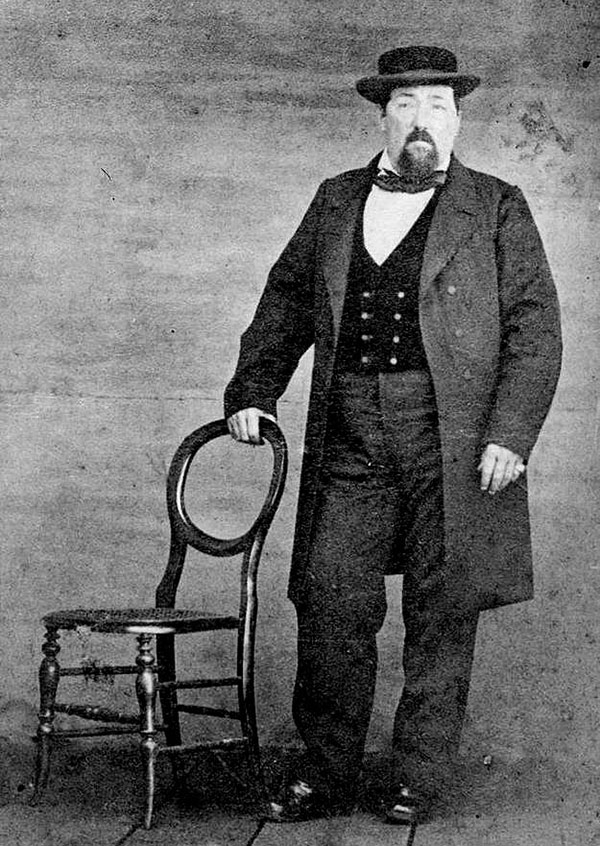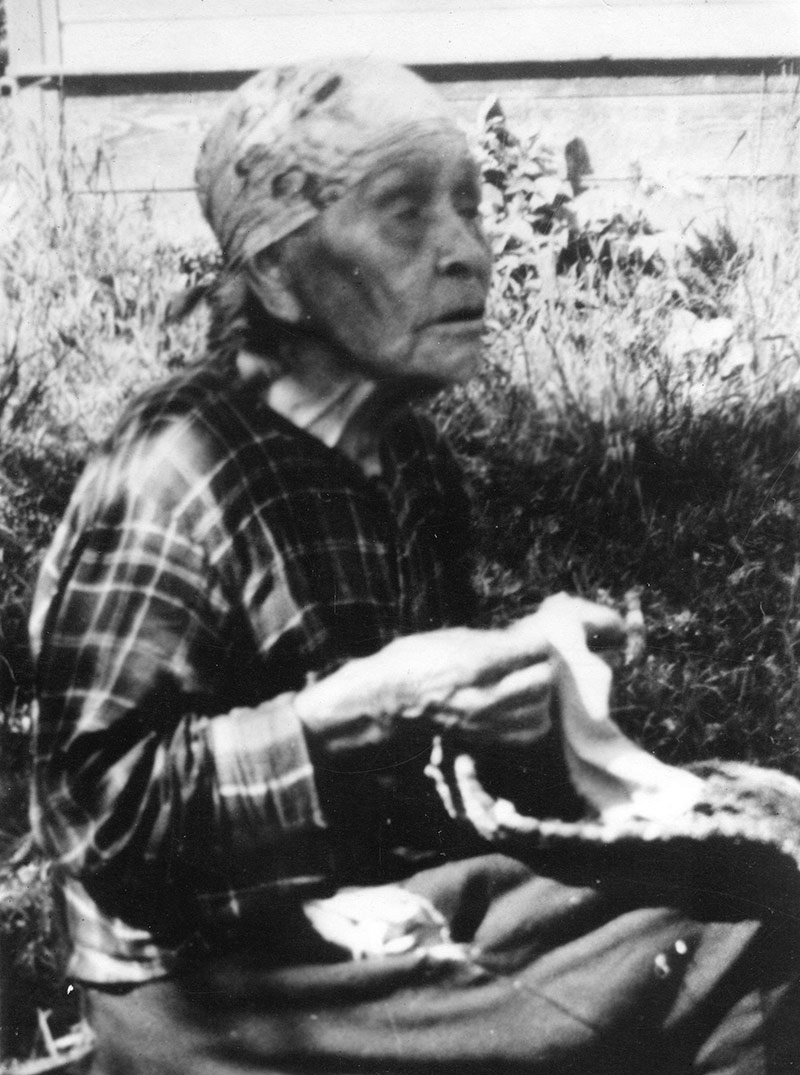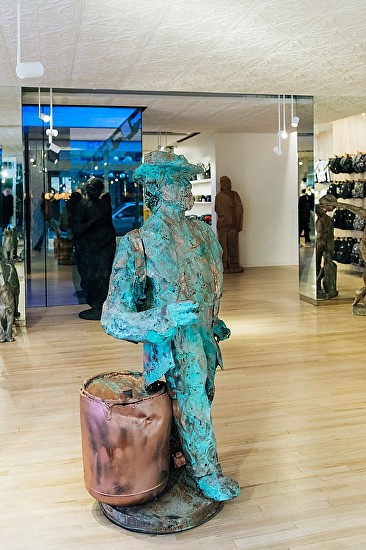The statue of Gassy Jack was supposed to be a Valentine’s gift to Vancouver.
In 1970, merchants and real estate developers wanted to spruce up the image of Gastown, one of Vancouver’s oldest neighbourhoods. They landed on John “Gassy Jack” Deighton as their mascot — a gold prospector, riverboat captain and saloon owner who lived a century prior.
They commissioned a rough-hewn likeness of Deighton, who stood on top of a whisky barrel at the corner of Water and Carrall streets for 52 years. Today, the Gastown area is known for its trendy bars, restaurants and nightclubs.
But this year, on a very different Valentine’s Day, Gassy Jack came down.
The Downtown Eastside Women’s Memorial March happens every year on Feb. 14. This year, as a crowd originating from the march gathered in a wide circle around the statue, a few youth pulled him down with rope. In his place they erected a wooden cutout of a red dress — a symbol of murdered and missing Indigenous women.
There’s a connection here. Gassy Jack was married to a Sḵwx̱wú7mesh (Squamish) woman called Kwa7xiliya, when he was 40 and she was still a child.
Kwa7xiliya was “a prominent young woman who was married at 12-years-old, but she was very mature and stood up for her rights and had the ultimate courage to leave Gassy Jack at that time,” said Wilson Williams, a band councillor with the Squamish Nation.
“She’s looked at as a role model for our nation, but she should be looked at as a role model for all Indigenous women.”
In 2020, a petition was launched to remove the statue, with the reasoning that “a pedophile’s likeness should not be prominently displayed in the centre of Gastown for fun tourist photo ops.” Protesters also defaced the statue with red paint.
So the City of Vancouver and the Squamish Nation began talks about what to do with the monument to Deighton.
Although the two parties agreed the statue had to go, they say they don’t approve of the way activists pulled it down on Monday. Video of the toppling shows a woman being pulled out of the way as the statue crashed down, appearing to narrowly miss hitting her.
The moment the statue came down. #GassyJack #vancouver pic.twitter.com/GZUja9qIwI
— ChantelleBellrichard (@pieglue) February 14, 2022
“Even though we don’t condone the toppling of the statue, we certainly understand the anger behind it,” Williams said. “The statue is a symbol of pain, trauma, violence, associated with colonialism and the violence against women.”
Vancouver Mayor Kennedy Stewart echoed Williams, saying that although Gassy Jack’s legacy was “abhorrent,” the way the statue was taken down was unsafe.
“I can definitely understand the anger,” Stewart said.
Gastown, with its touristy shops and trendy watering holes, lies beside the Downtown Eastside, an impoverished neighbourhood where 10 per cent of residents identify as Indigenous, compared to two per cent in Vancouver as a whole.
While some of those residents are from local First Nations, others come from home communities from across B.C., the Prairies or other parts of Canada.
Both Williams and Stewart acknowledge the city and the Squamish Nation could have done more to communicate their plans for the statue to Downtown Eastside residents, the wider urban Indigenous community and the general public.
While there was a note about the consultation process affixed to the statue, it was left standing in a neighbourhood where the harms of colonialism and violence against women continue every day.
Who was Kwa7xiliya?
While millions of locals and tourists visit Gassy Jack and read the story on his plaque each year, the story of Kwa7xiliya has not been memorialized in the same way.
Kwa7xiliya, whose name is sometimes spelt Quahail-ya, was about 12-years-old in 1870 when she went to care for an aunt who had fallen ill.
Her aunt was married to Deighton, and they lived at Vancouver’s Granville Townsite, which would later be called Gastown after Deighton’s nickname.
Deighton was called “Gassy Jack” because he was so chatty, “gasser” being Victorian slang for a talker.

Kwa7xiliya’s aunt died the year that she went to care for her, and Kwa7xiliya ended up marrying Deighton, who was about 40 at the time. She became known as Madeline Deighton.
It was common for settler men to marry Indigenous women in the 1800s, and it was common for women to marry during their teens.
But in any culture, it’s difficult to imagine a 12-year-old being able to make an informed decision to marry a man 28 years her senior, historian Michael Kluckner recently told the CBC.
“There’s an 1886 newspaper article which is really the only source of that period, where the writer is saying that Deighton and his wife had a little cabin back in the forest where Kwa7xiliya presided and to where he retreated from his saloon for peace and quiet,” Kluckner said.
“And there’s this section about how she would leave him, it says about twice a month, but taking all the furniture, and then Jack would go to the reserve and buy her again. Which seems to either imply that she was going back because she was being abused and then he would go there and pay money to her family and she would come back. But it’s very, very difficult to figure out what’s going on.”
What’s clear from historical sources, Kluckner said, is that Deighton was a “ne’er do well.”
“There wasn’t a law that he wasn’t going to turn around and defy,” Kluckner said, “whether as a bootlegger or grabbing property [that] legally… didn’t belong to him.”
After Gassy Jack died in 1875, he did leave money for Kwa7xiliya and their son in his will. But “when Deighton’s brother and sister-in-law came from England to tidy up the affairs, they managed to get her disinherited,” Kluckner said.
Kwa7xiliya later remarried a Sḵwx̱wú7mesh man known as “Big William.”
In 1940, Major James Matthews, the city’s first archivist, visited Kwa7xiliya, who was living with her granddaughter at the Sḵwx̱wú7mesh community of Eslha7an, also known as the Mission reserve on the North Shore.
Kwa7xiliya said she was “very poor” at the time. She was more fluent in her own language than English, though Matthews recorded some of her life story, and her recollection that Deighton was a “nice, good man.”
She died in 1948 at the age of 90.

Today, descendants of Kwa7xiliya still live in the Sḵwx̱wú7mesh community, and it’s important they are properly consulted, said Williams. He’s reached out to the Squamish Nation’s administrative team to get an update on that process.
Williams is also firm that it’s Sḵwx̱wú7mesh people who need to lead the process.
“Our door is always open with regards to people reaching out and fact-finding our connection to the lands, our history in the lands and our language culture and traditions — they’re deeply rooted in Vancouver,” he said.
A barkeeping ‘founding father’?
Though the City of Vancouver is in talks with the Squamish Nation about what to do with the statue of Gassy Jack, it wasn’t the city who put the statue in Gastown in the first place.
In the late-1960s, Gastown merchants and developers saw that their neighbourhood was in decline and wanted to shepherd its rebirth into an entertainment and heritage district.
Gastown was at the time stigmatized by investors as being full of “hippies and bums,” but the businessfolk saw its potential to become Vancouver’s version of San Francisco’s Ghirardelli Square.
It was from this effort that Gastown eventually got its steam clock, paid for by merchants, and faux cobblestone roads, installed as part of a neighbourhood beautification program in the mid-1970s.
Gassy Jack was part of this too. One of the Gastown developers approached artist Vern Simpson about doing a piece of public art, and Simpson suggested Gassy Jack. (The Tyee has requested an interview with Simpson but has not yet heard back.)
He completed it in 1970, and it was installed in Gastown by the merchants as a Valentine’s Day gift to the city.
Then-mayor Tom Campbell did not like the statue, saying it blocked traffic, and he threatened to have it hauled away to the city dump. But the city couldn’t remove it, because it was installed on private property near the site of Gassy Jack’s old saloon.
Even in Gassy Jack’s first year in Gastown, he was the target of vandals. Someone decapitated him, and a $50 reward was posted for the return of his head. It was later found in a parking garage and reinstalled.
Simpson would later create a second Gassy Jack. Once again, it was commissioned by private interests, this time by the Vancouver-based Herschel Supply Co., known for its popular retro backpacks and accessories. “Gassy Jack II” sported a backpack, a nod to Herschel’s products.
But by the late 2010s, monuments to historical figures were being questioned.
In Victoria, B.C. in 2018, city council voted to remove a statue of Sir John A. Macdonald, Canada’s first prime minister, who oversaw the implementation of residential schools among other atrocities against Indigenous people. The decision happened after a year of discussion with Indigenous people and the wider community.*
At the end of a 2021 walk in Winnipeg to commemorate children who died in residential school, people pulled down statues of Queen Victoria and Queen Elizabeth.
In 2020, when 23,000 people signed the petition to remove the Gassy Jack statue, Herschel decided to remove the statue from its store.

“His memory needs to be changed,” said Ginger Gosnell-Myers, a fellow of decolonization and urban Indigenous planning at SFU’s Morris J. Wosk Centre for Dialogue.
Gosnell-Myers said she was relieved to see that the statue is finally down.
However, she notes that it wasn’t done in co-ordination with Vancouver’s host nations or the women’s march leaders: “I think what happened with Gassy Jack is a response to not enough happening, and people are frustrated.
“We just assume that every monument is a homage to a great person. But Gassy Jack — he was a bar owner! He wasn’t a great man. Whoever thought he deserved to be memorialized, their judgment is questionable, when there are so many stories that can be memorialized that reflect things that we need to learn about.”
If Indigenous history is invisible next to monumentalized colonial history, the “longer ignorance will exist,” she said. “It also normalizes that this work is harder than it needs to be.”
The recently defaced statue was hauled away by the city and put into storage. The next steps “will be determined” by the Squamish Nation, according to the city.
But at the moment, Gassy Jack no longer stands in Gastown.
* Story updated on Feb. 18 at 10:41 to correct information about the circumstances that preceded the removal of the John A. Macdonald statue in Victoria. ![]()
Read more: Indigenous, Rights + Justice, Municipal Politics

















Tyee Commenting Guidelines
Comments that violate guidelines risk being deleted, and violations may result in a temporary or permanent user ban. Maintain the spirit of good conversation to stay in the discussion.
*Please note The Tyee is not a forum for spreading misinformation about COVID-19, denying its existence or minimizing its risk to public health.
Do:
Do not: